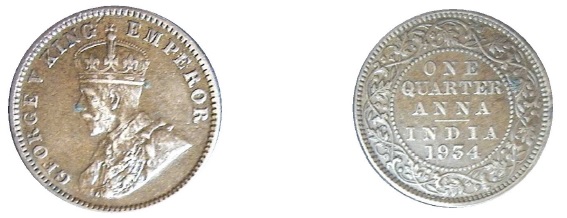The article below is reproduced with the kind permission of the author, Mr Fred Lever. This article, and others, are available as a reference book. If you’d like to buy a copy, please contact me and I'll pass on the message to Fred.
1916-I halfpenny mule coin
The most famous mule coin observed in the pre-decimal series is the 1916-I halfpenny, where an Indian Quarter Anna obverse die was paired with an Australian Commonwealth halfpenny reverse.
Of course, the most famous decimal mule coin is the 2000 One dollar/ten cent mule.
The planchet weight and size of the Australian coin and the mule coin are the same, about 5.6 grams and 25.5 mm x 1.4mm. The word mule is used as the coin is the offspring from two different breeds of parent dies. Other coins resulting from dies of the same breed but with detail differences could be called hybrids.
The planchet weight and size of a Quarter Anna is about 4.7 grams and 24.7 x 1.2mm; it is a noticeably thinner and smaller coin. The obverse rim on the mule is wider than either type of normal coin. As the Indian mint had both types of dies on hand the reason for the coins existing is most likely a simple die setting error. All 1916 mules are typically worn as the existence was only realised in the 1960’s. Refer to Renniks Coin and Banknote guides and The Australian Coin Review, January 1967, Vol 3 No 7, for further information. Scurrilous traders have offered newly struck copies as the genuine article, be very aware of this. A genuine coin will have a provenance and a very high price tag! Mintage is unknown and possibly five to ten genuine coins exist.
A 1934 Quarter Anna, above, and a 1916-I halfpenny, below. The 1916-I mule halfpenny
is made up of the Quarter Anna's obverse and the halfpenny's reverse.
"Hybrid" coins
Some coins, better described as “hybrids”, exist in the penny series. Across the 1920s and 1930s, obverse dies from different mint years or mint origins were interchanged. The coins still have the correct Australian patterns on the faces; the different dies are described as “London” or “Indian” dies and are identified by the bead alignment or arrangements of the dots in the design.
The most popular later coins are the 1955 Perth penny with the then new (1956) obverse 4 die instead of obverse 3, and the 1956 Perth minted penny with the older (1955) obverse 3 die instead of the newer obverse 4. The reason given for the pairing appears to be expediency in production.
The obverse is recognised by the relation of the points of the letters A and I in the word “gratia” to the rim beads. Obverse 3 points at a rim bead, obverse 4 points between rim beads. A 1955 or 1956 hybrid coin must be a Perth minted issue with the dot after the Y in “penny”.
 Change website currency
Change website currency 







Comments